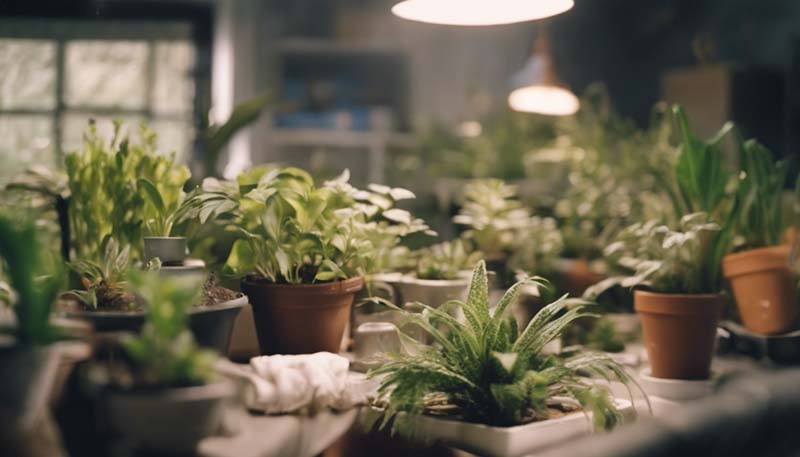The Role of Temperature in Indoor Gardening
Temperature is one of the most critical factors in indoor gardening. It can significantly impact plant growth, yield, and overall health. In this article, we will explore the role of temperature in indoor gardening and provide tips for maintaining optimal temperature conditions for your plants.
Introduction
Indoor gardening has become increasingly popular in recent years, as more people are looking for ways to grow their own food and enjoy the benefits of having plants in their homes. However, growing plants indoors comes with its own set of challenges, one of which is managing temperature.
Advertisement
Temperature plays a crucial role in the growth and development of plants. It affects various physiological processes, such as photosynthesis, respiration, and transpiration. In indoor gardening, maintaining the right temperature is essential to ensure healthy plant growth and prevent diseases and pests.
Understanding Temperature and Its Effects on Plants
Temperature affects plants in several ways:
- Photosynthesis: Higher temperatures can increase the rate of photosynthesis, leading to faster plant growth. However, extremely high temperatures can cause the process to slow down or stop altogether.
- Respiration: Respiration rates also increase with temperature. This can lead to increased energy consumption and reduced growth if temperatures are too high.
- Transpiration: Higher temperatures can cause plants to lose more water through transpiration, which can lead to dehydration and wilting if not managed properly.
- Enzyme Activity: Enzymes are proteins that facilitate various biochemical reactions in plants. Temperature affects enzyme activity, and extreme temperatures can disrupt these reactions, leading to reduced growth and productivity.
Optimal Temperature Ranges for Indoor Plants
Different plants have different temperature requirements. Some plants thrive in warmer temperatures, while others prefer cooler temperatures. Here are some general guidelines for the optimal temperature ranges for various types of indoor plants:
- Tropical plants: 65-85°F (18-29°C)
- Warm-weather plants: 60-75°F (15-24°C)
- Cool-weather plants: 50-65°F (10-18°C)
It's essential to research the specific temperature requirements of your plants and adjust the temperature in your indoor garden accordingly.
Factors Affecting Temperature in Indoor Gardens
Several factors can affect temperature in indoor gardens, including:
- Sunlight Exposure: More sunlight exposure can lead to higher temperatures. South-facing windows typically receive the most sunlight and can become quite warm.
- Heating and Cooling Systems: The heating and cooling systems in your home can significantly impact the temperature in your indoor garden. Make sure to adjust these systems to maintain the optimal temperature for your plants.
- Insulation: Proper insulation can help maintain a consistent temperature in your indoor garden. Make sure your growing area is well-insulated to prevent heat loss or gain.
- Humidity: Humidity can also affect temperature. High humidity can make the air feel warmer, while low humidity can make it feel cooler.
Managing Temperature in Indoor Gardens
Here are some tips for managing temperature in your indoor garden:

- Monitor Temperature: Use a thermometer to monitor the temperature in your indoor garden regularly. This will help you identify any temperature fluctuations and make adjustments as needed.
- Provide Adequate Ventilation: Good ventilation is essential for maintaining optimal temperature and humidity levels. Make sure your indoor garden has adequate ventilation, such as fans or vents, to prevent overheating or stagnant air.
- Use Shade Cloths or Screens: If your indoor garden receives too much sunlight and becomes too warm, consider using shade cloths or screens to block out some of the sunlight and reduce the temperature.
- Insulate Your Growing Area: Insulating your growing area can help maintain a consistent temperature and prevent heat loss or gain. Use insulating materials such as foam boards, reflective insulation, or thermal curtains to insulate your indoor garden.
- Use Heating or Cooling Devices: If necessary, use heating or cooling devices to maintain the optimal temperature for your plants. Space heaters, heat lamps, or air conditioners can be used to regulate the temperature in your indoor garden.
- Water Wisely: Watering your plants can also affect the temperature in your indoor garden. Watering during the cooler parts of the day can help prevent overheating and reduce the risk of diseases and pests.
Conclusion
Temperature plays a critical role in indoor gardening, and maintaining the optimal temperature is essential for healthy plant growth. By understanding the effects of temperature on plants and managing the temperature in your indoor garden effectively, you can create a thriving indoor garden that produces abundant, healthy plants.
Comment